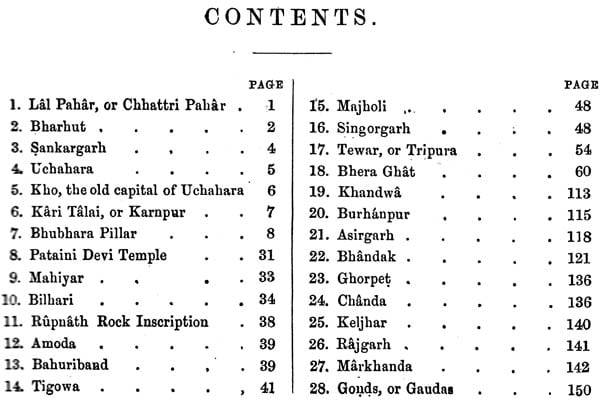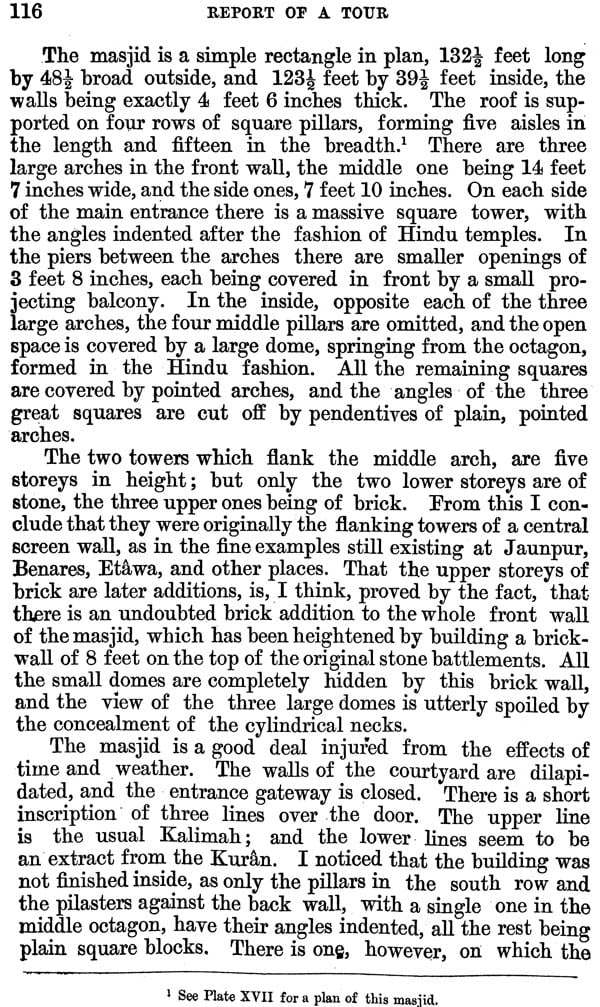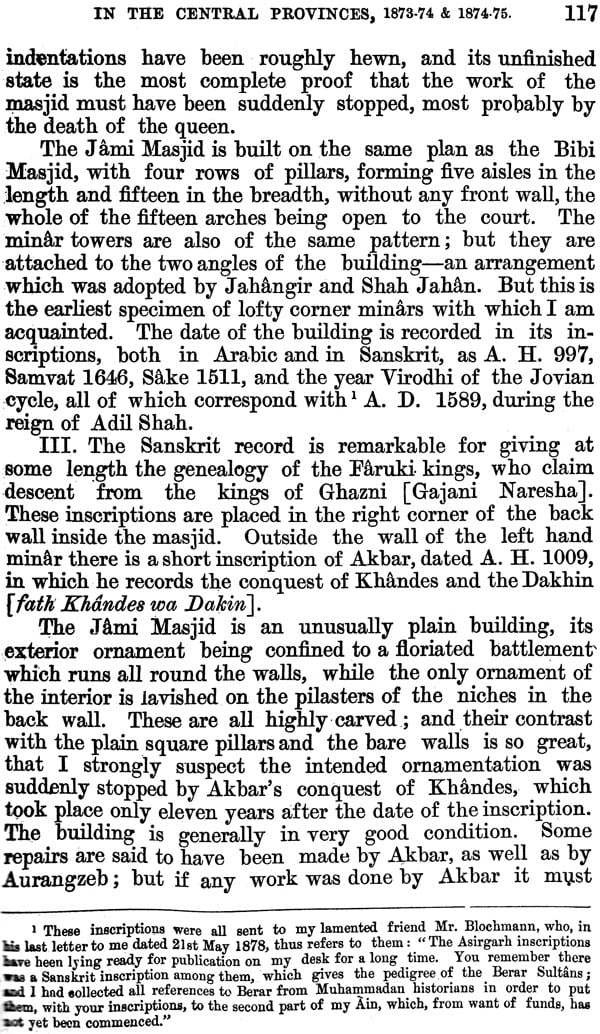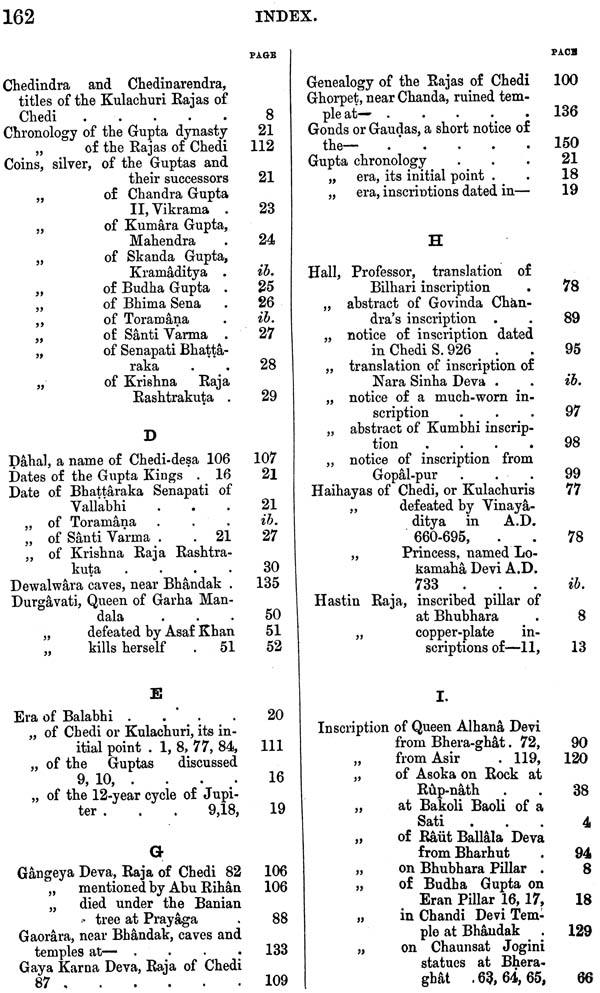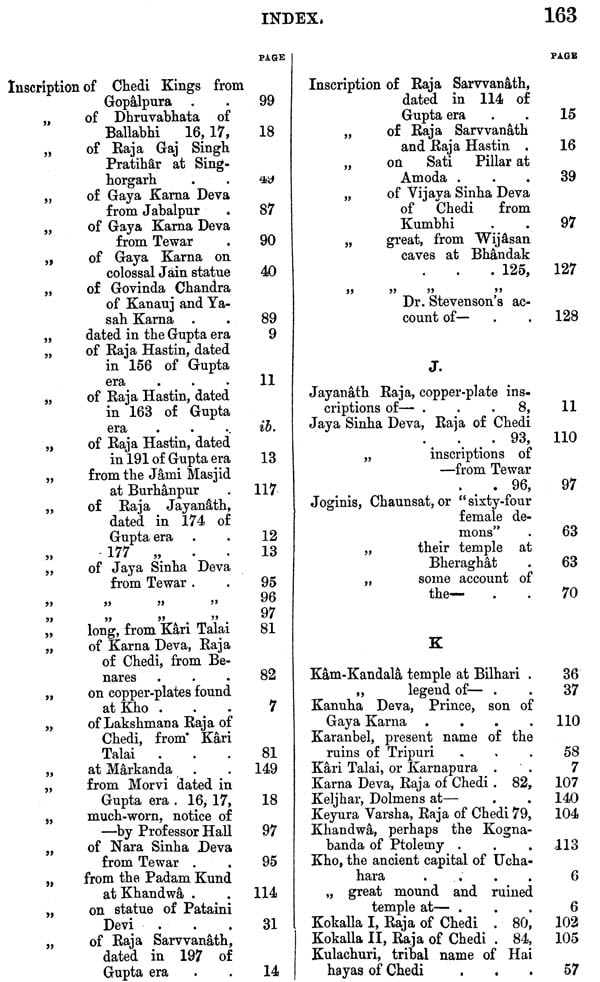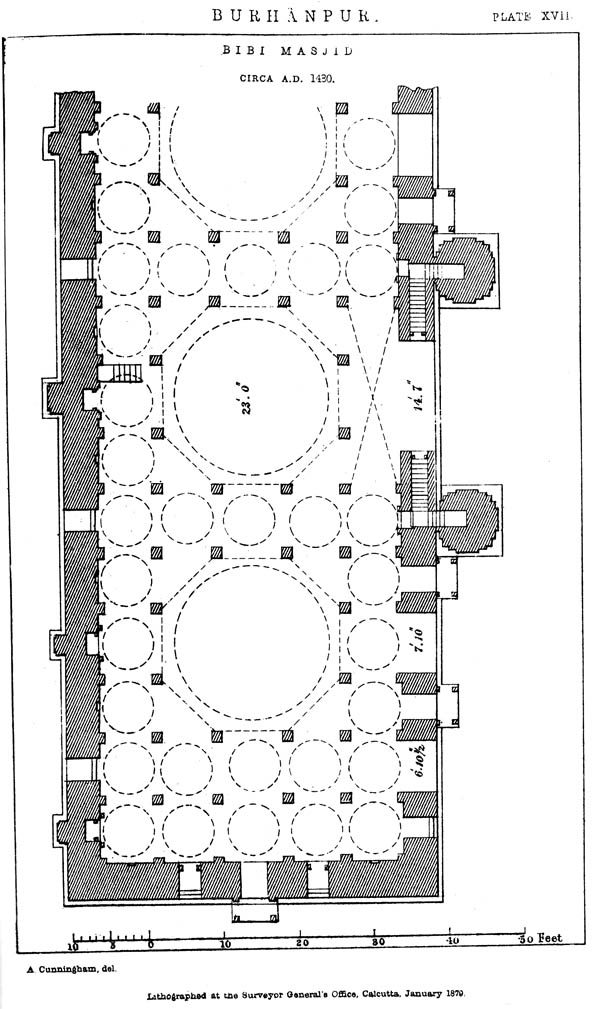
Archaeological Survey of India Report of A Tour in the Central Provinces in 1873-74 and 1874-75 (Volume 9)
Book Specification
| Item Code: | NAW455 |
| Author: | A. Cunningham |
| Publisher: | ARCHAEOLOGICAL SURVEY OF INDIA |
| Language: | English |
| Edition: | 2000 |
| Pages: | 206 (30 b/w Illustrations) |
| Cover: | HARDCOVER |
| Other Details | 10.00 X 7.00 inch |
| Weight | 630 gm |
Book Description
The tour described in the present volume extended from Bharhut, half-way between. Allahabad and Jabalpur, to Air and Burham on the west, and to Chanda and Mandarin on the south, thus covering nearly the whole of the western half of the Central Provinces. In the middle ages the greater part of this country belonged to the Ku la-churi Rojas of Chedi or Oldhall. At a still earlier date the northern tract, about Ucha hara and Maharishi, was subject to two petty chiefs, or simple Maharajas, who were tributary to the powerful Gupta Kings, in whose era they date all their inscriptions, Notices of all these records are given in the following pages, with facsimiles of the dates in the accompanying Plates.
The occurrence of these dates has given me an opp or unity of discussing the probable starting point of the Gupta era, which I have fixed approximately to the year 194 A.D. Four of these inscriptions contain a second date in the twelve-year cycle of Jupiter, which, I think it probable, will ultimately lead to the discovery of the true initial point of the Gupta era. I am not at present in possession of all the information necessary for the full discussion of this question; but I may note here that the years of this cycle of Jupiter have the same names as the twelve months of the year, with the addition of the word Mad, or great, prefixed to each. Thus the year 156 of the Gupta era is also called he year Mad V. hatstands, while the year 209 is named Maha Aswarby. Now the difference between these two dates is 53 years, or 5 years over 4 cycles of 12 years; and as Asa yuga is the fifth name in order after Vaishnava, we thus learn that between the years 156 and 209 of the Gupta era there was no name omitted in the regular succession of the twelve years. But according to the old Astronomer Ganga the names of Aswarby and Chair were omitted after the lapse of average periods of 85 years, so as to make the name of the year agree with that of the Astrakhan group, in which Jupiter actually rose helically. I have not yet been able to ascertain to my satisfaction what arrangement was act ally followed in making these omissions, and I will not hazard any speculations as to the name of the year, which probably corresponds with A.D. 350, which, according to my proposed chronology of the Gupta, was the year Maha Vaishnava. - I hope, however, to obtain hereafter some positive information regarding the exact recurrence of these omitted names, which may then be brought to bear upon the initial point of the Gupta era. In the meantime, I wish to draw attention to the data furnished by the inscriptions of Buddha Gupta and Mahabharata, from which I have deduced the probable commencement of the Gupta era in 194 A.D.
I have also given a short account of the silver coins of the Gupta and their successors, amongst which will be found the coins of two new kings—named Biham Sean and Santo Varma. Since the plate was prepared, I have received the coin of a later Gupta King, with face to the right, as on all the Gupta coins. The coin is of rude and Coarse execution, and must therefore be considerably later than the coins of Skanda and Buddha Gupta. The name consists of four syllables, which I read, with some hesitation. as to the first, as Cardamom Gu(PTA). The coin was obtained at Ajudhya, and bears on the reverse the usual Gupta pea- cock with expanded tail. The whole legend seems to read as follows :—
Devajaya viji [tava] niravani patti Démodara Gu(pta).
The name of Damodara Gupta is found in the Aphsar inscription of the later Guptas. He was the son and suc- cessor of Kumira Gupta II, who was the opponent of Santi Varma. DAmodara must therefore have reigned, according to my calculation of the Gupta chronology, from about 460 to 480 A.D., a date which agrees with the statement of the inscription that he had successfully encountered "at the battle of Maushari the fierce army of the Western Hunas."
I have also given a pretty long account of the Kulachuri dynasty of Chedi, illustrated by numerous inscriptions. All of these are dated in an era, of their own, which is called both Chedi Samvat and Kulachuri Samvat. The starting point of this era I have fixed with some certainty in the year 249 A.D. My account of the era is founded partly on the mention of the Kulachuri Kings in the dated inscrip- tions of other dynasties, and partly on the mention of several week days in some of their own inscriptions. After- wards I was lucky enough to find two separate notices of the Chedi Kings by independent authors, which serve to establish the correctness of the date that I have assigned to the beginning of the era.
The first of these notices is a very short paragraph of Abu Rihan, the contemporary of Mahmud of Ghazni, which has escaped the notice of all previous enquirers. After mentioning KAlanjar he says, "thence to Dahal, of which the capital is Bituri, the kingdom’ of Kankgu." Now these names are only a slight disguise in Persian characters for Déhal, which was another appellation of the country of Chedi, of which the capital was Tripuri, or Tripura, and the Raja was Gangeo, or Gangeya Deva. Abu RihAn’s account refers to the year 1080-3) A.D., while the reign of Gaéngeya is fixed by the genealogical reckoning of my chronology to the period between A.D. 1025 and 1050. The second notice is in Dr. Buhler’s account of Bilhana, the author of the VikramAnkadeva Charita.' Bilhana was born at Khonamukha, in Kashmir, and left his native country between 1062 and 1065 A.D. He visited Mathura, Kanauj, Prayag, and Benares, and afterwards " resided for some time at the court of the Chandela Chief Karna in Déhala, or Bundelkhand; and it was here, he tells us, that he gained his victory over the poet Gangdhara."’ Eventually he be- came the court poet of the Chalukya King VikramAditya Tribhuvana Malla of Kalyana. As his life of this king was written about A.D. 1085, the date of his residence at the court of Raja Karna of Dahala may be placed about A.D. 1070 to 1075, a period which agrees exactly with the approximate date of A.D. 1050 to 1075, which I had already assigned to him by the genealogical reckoning. In this notice I have retained the statement that Karna was the Chandela Chief of DAhala, or Bundelkhand, for the purpose of correcting the widely-spread mistake that Chedt was identical with Chandel. This error, I believe, originated with Lieutenant Price, the translator of the Man inscription of the Chandel Rajas. After describing how Madana Varma Chandela had vanquished the King of Cheds ‘in the fierce fight," he adds in a note, "the same, I believe, with Chandail," so that Madana Varma must have conquered himself.* Now Chandela is the tribal name of the Rajas who ruled over the country of Mahoba, Khajuraho, and Kalanjar, which is called Jajahutt by Abu Rihan, and Jea-kasukti in one of the Prithi Raj’s inscriptions. There is besides no Karna in the Chandela lists of kings. But Karna of Ddhala is the well-known Raja Karna of Chedi, which country, according to Hema Chandra, was also called Déhala. I may add that Karna himself and all his descendants bear the titles of Chedindra and Chedinarendra, or "Lord of Chedi," in all their inscriptions.
I have also given a full account of the curious Buddhist caves af Bhandak, near the WardA River, and of the fine group of temples at Markanda on the Venya Gang&é River. As both of these places are in the ancient district of Vikdtaka, I have suggested that Bhdndak is only the modern abbreviated form of the old name.
**Contents and Sample Pages**
